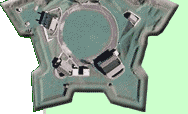A variety of French 'n' British squabbles of the period caused Nova Scotia to be ceded back to France in 1632, sending the depressed Scots back to what they no doubt now thought of as Seneca Scotia, since they felt it was so cool to rename things in Latin.
Charles de Menou d'Aulnay (1604-1650), an assistant to the French governor of Acadia, set about refortifying Port Royal in expectation of trouble with the English. By 1702, construction of the fourth and final fortification at Port Royal began in the
Vauban style, which is the lovely sight we see there today.
For much of the 17th century, up until 1710, Acadia was governed from this location. The French Governor, his officials and a garrison lived at the fort. This all came crashing down in the autumn of 1710, however, with the arrival of the British fleet.
Queen Anne's War was fought from 1702 to 1713 by France and Great Britain, and since so much colonial leaping about was underway in the New World, the war made it to Spanish Florida, Acadia and Newfoundland. In 1710 the British laid siege to the vastly outnumbered garrison at Port Royal. After a week-long siege, on October 16 the fort and town were surrendered by French Governor Daniel d'Auger de Subercase (1661-1732). In a gleeful British orgasm of renaming, the island was once again known as Nova Scotia, the town was renamed Annapolis Royal, the river became the Annapolis River, and the fort was renamed Fort Anne, named of course for Queen Anne (1665-1714), who was also fortunate enough to have the whole war named after her.
Acadia still existed, although in theory it was now owned by the British, who continued to govern the area from Fort Anne. The borders of what was Acadia were indistinctly fuzzy, the people living there were convinced that the French would return to power sooner or later, and Acadia's population of Frenchish folks grew rapidly over the next few decades.
King George's War (1744-1748) saw no fewer than three French attempts (one each in 1744, 1745 and 1746) to wrest the pretty, Vaubanny Fort Anne back from the British, all of them unsuccessful. The British continued to govern the Acadians, Mi'kmaqs and British colonists from Fort Anne until 1749, when Halifax was made the British capitol city of Nova Scotia.
From 1754 to 1763, the Seven Years' War (or French and Indian War, as it's known in the US) raged in Europe and North America betwixt the French and British (surprise!). One result of this conflagration was that the Acadians, always more loyal to France than to their current British overlords, were rounded up and ejected from Acadia. Over 10,000 of them were crammed onto ships and dispersed throughout British colonies in Massachusetts, New York, Connecticut and South Carolina.
British victories in this war, most notably their defeat of Louis-Joseph de Montcalm (1712-1759)'s forces at Quebec in 1759, moved the contested frontiers and made Fort Anne less militarily important: Almost all of France's colonial holdings in Canada were ceded to the British. A cool starfort is difficult to abandon completely, however, and Fort Anne was used as a British outpost to defend the town from pesky American privateers during the American Revolutionary War (1775-1783), who attacked the fort without much result in 1781. More troops were stationed at the fort during the War of 1812 (1812-1814), but garrison duty there proved peaceful.
The lovely white building seen in the top photograph was constructed in the 1790's as an officers' quarters. The British remained at Fort Anne until 1854, when they withdrew for the last time, and the fort began to deteriorate.
The town of Annapolis Royal prospered through the latter half of the 19th century, and an interest in the preservation of their cool fort took root. In 1917, Fort Anne became Canada's first administered national historic site.
Today, Fort Anne is open to visitors on a regular basis for most of the year.





